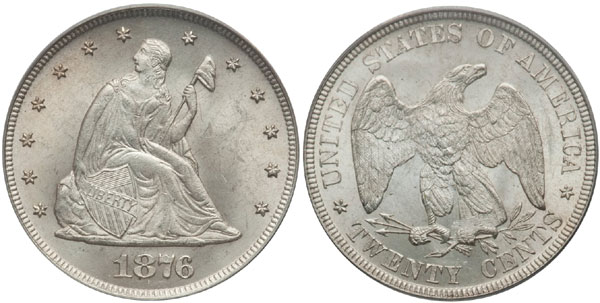Guide to U.S. Liberty Seated Twenty Cent Pieces
Along with the two and three cent pieces, the Twenty Cent Piece was one of the briefly produced, odd denominations of the United States monetary system. Struck for circulation for only two years, followed by an additional two years of proof-only strikings, the coins were highly unpopular and broadly rejected by the public. Although the Twenty Cent Piece may have made logical sense, the public confusion arising from the similarity to the quarter dollar resulted in limited use within commerce and a quick demise for the denomination.

The twenty cent denomination traces its origins to the lobbying efforts of the Western States. The Comstock Lode was still yielding huge amounts of silver, but the only high denomination silver coins being minted were the half dollar and trade dollar, which at the time was used for export and lacked legal tender status. A new silver denomination would potentially use more Nevada silver. Additionally, there was a shortage of small change in the west, where base-metal coins were not widely accepted. Mark Twain described the problem in Roughing It, where he said that with the nickel not circulating, there was a shortage of change when goods were priced less than a quarter. This caused higher prices for no apparent reason other than a lack of coin.
A bill to authorize the Twenty Cent Piece was introduced by Senator John P. Jones of Nevada in 1874. In anticipation of the bill’s passage, Mint Director Henry Linderman had a large number of patterns created for the new denomination. Many were struck in a combination of different metals, usually silver, copper and aluminum. The most famous of these patterns is the “Liberty by the Seashore” design by Chief Engraver William Barber. The obverse carries an image of Seated Liberty on the seashore with a ship and the ocean visible in the background. The bill would be signed into law on March 3, 1875 and designs would be approved shortly thereafter.
The final obverse design would be a modification of Christian Gobrecht’s Seated Liberty design, which had been introduced in the late 1830’s and was still found on most silver coins in circulation. The new Twenty Cent Piece would feature the same image of seated Liberty surrounded by thirteen stars, but with some of the details re-engraved by William Barber.
The reverse would feature the eagle design that had first appeared on the Trade Dollar in 1873. An eagle is shown with its wings spread, grasping an olive branch and arrows in its talons. The inscription UNITED STATES OF AMERICA appears above, with the denomination TWENTY CENTS below. Notably, the mottoes E PLURIBUS UNUM and IN GOD WE TRUST do not appear on the coins. The former was mandated by a modification of the law in 1873, and the latter was not required but had been included on various denominations at the discretion of the Secretary of the Treasury. The explanation given for the lack of the mottoes was that the size of the coin was too small to contain them.
The Twenty Cent Piece would be struck with a plain edge in order to differentiate the denomination from the similarly sized quarter dollar. Additionally, the inscription LIBERTY on the obverse shield was raised rather than incused. Unfortunately, these differences were not prominent enough and the denomination quickly failed. A bill to repeal the denomination was introduced in July 1876, although it would take two more years for the bill to be enacted. In the meantime, production dwindled with only a small number of pieces struck in 1876, followed by two years of proof-only issues at the Philadelphia Mint. The denomination was officially abolished when legislation was passed on May 2, 1878, bringing an end to the unusual and short-lived series.

